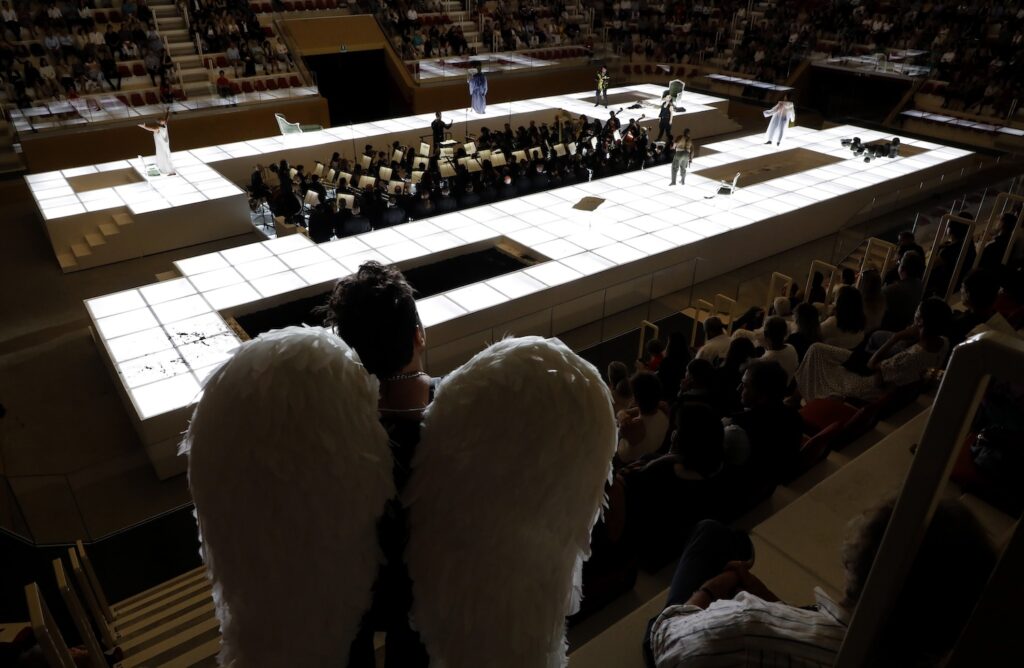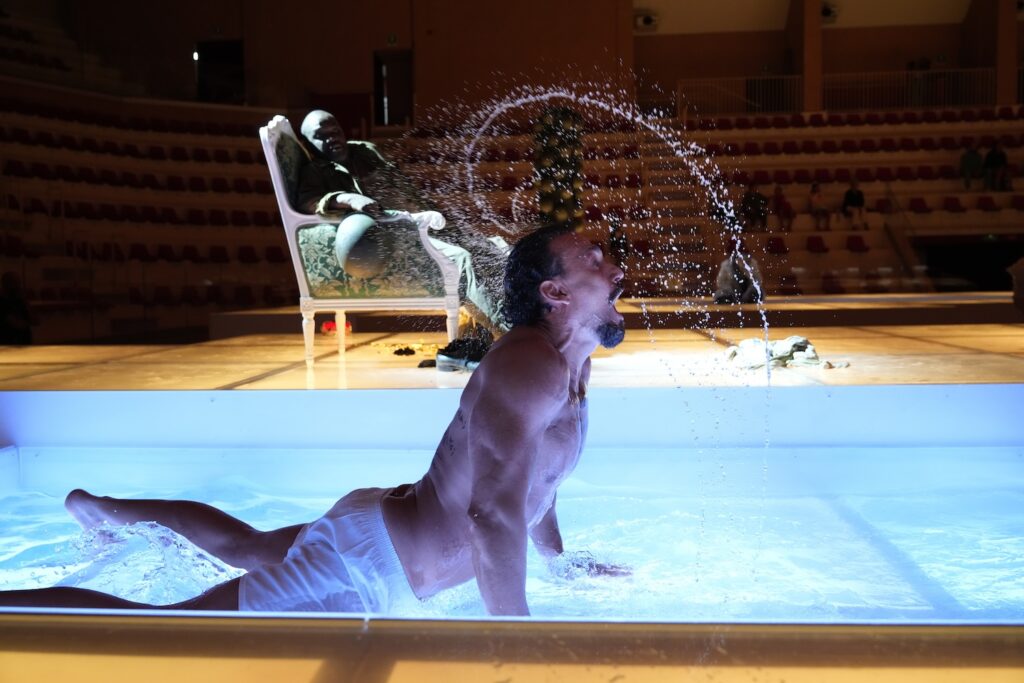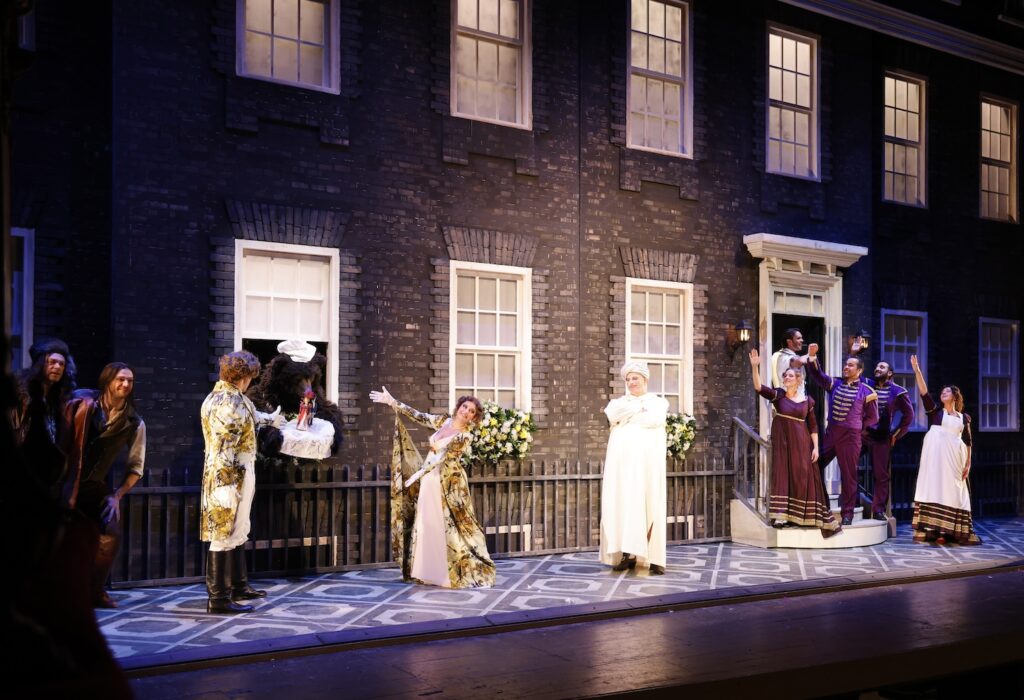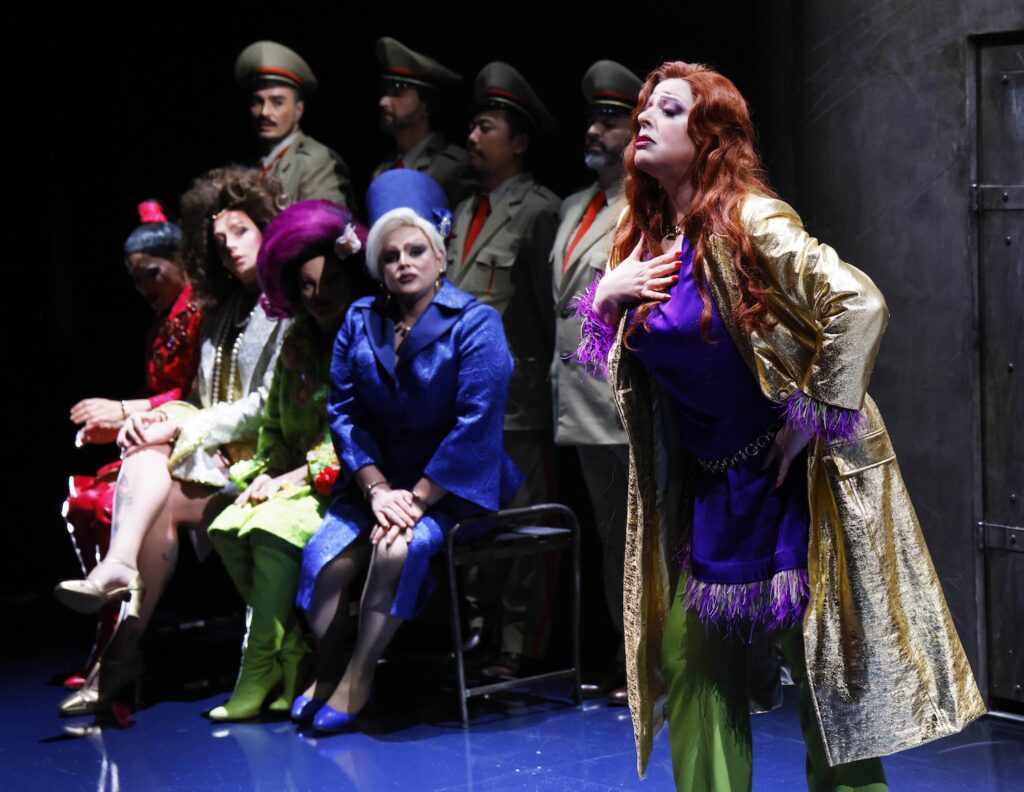The last of the Neapolitan tragic masterpieces, the very first farce, and the first of the famous comedies. The 2025 Rossini Opera Festival was of limited success.
The success limited to the Zelmira, though it was generally disliked by a baffled public. It was staged by Spanish stage director Calixto Bieito, one of the world’s more controversial, if important directors. This Zelmira was the festival’s step back into the realm of high-brow theater, notably rare since the previous Zelmira, 16 years ago.
That one took place in the Festival’s temporary home, the Adriatic Arena (now called the Vitrifrigo [boat refrigerators] Arena) while the ROF’s Palafestival was being transformed into the Scavolini [kitchens] Auditorium, which is actually the [unused] practice court for Pesaro’s famed basketball team Victoria Libertas.
The transformation was finally completed last year, 16 years in the making. Though rather than use it in its theater configuration Mr. Bieito used it in its basketball configuration, surrounded by 1400 tiny seats, many unusable, on five treacherous, concrete stadium gradations.
Discomfort and basketball acoustics aside, Bieito’s Zelmira was a fascinating attempt to impose high concept, contemporary theater onto a Rossini genre piece. Though exactly what the Bieito concept may have been remains elusive. So Bieito looked for a story of sorts that maybe was hidden in the same Lesbian history, or maybe not, for much the same reason that Rossini had used this bit of theatrical history according to opera.
Above all else it was highly distilled story telling, Rossini’s complicated Lesbian (Isle of Lesbos) history of no importance to Bieito, as it had been of no importance to Rossini either, for whom it was merely an excuse to show off.
To wit (mostly ignoring Rossini’s cloak of history): Leucippo loves Antenore, Emma loves Zelmira, Zelmira nurses (literally) Polidoro back to health, Ilo wanders in from somewhere, all under the non-singing gaze of a Greek guy who was dug up from a pit of dirt during the overture. Not to forget Zelmira’s non-singing son who ran around the stage for much of Act II. You can bet that all this derives, if obliquely, from the Tottola libretto.
The Bieito theatrical stamp was exacerbated by placing the opera’s action on the basketball court. So no matter where you sat, like at a basketball game, there could be a player not too far from you from time to time. Not to mention that sometimes a principal singer or a block of choristers stood just beside you, singing, to find their way ultimately to the stage. It was a unique opportunity for an audience to be inside an opera production, together with its players. Ovations were very long, even by Pesaro standards.
Mr. Bieito constructed a huge, flat box that covered the basketball court floor, the top of which, in marked squares, was the stage, lighted from time to time in various colors from underneath. There was a hole cut in the middle to house the orchestra (that of Bologna’s Teatro Comunale) and conductor Giacomo Sacripanti. The famed, young maestro maintained a firm grip on his 360 degree responsibilities, offering unfaltering, quite precise support to his singers throughout the evening, attaining with consummate grace the musical euphoria unique to Rossini’s tragedies.
Besides the orchestra pit there were cut out holes / pits on the stage —a pool of water on one end, a pit of dirt on the other, complemented by a couple of smaller refuge pits. In a magical coup de théâtre the platform divided into two long-ways halves (see photo) during the Act I finale, to rejoin during Act II. The pool seemed to be a place of sexual immersion, perhaps of fulfillment (Leucippo writhed in death throes there in, Emma immersed herself). In the beginning the Greek observer was unearthed from the pit of dirt, Antenore threw himself into the dirt from time to time. Ilo (Zelmira’s absent husband) cowered lengthily in the refuge.

With the high vocal and musical standards of the production, or because of these high standards, this Pesaro Zelmira will surely be recognized as one of Calixto Bieito’s finest accomplishments. Zelmira was sung by Anastasia Bartoli ([lead photo] daughter of mezzo soprano Cecilia Gasdia), a powerful performer who commanded the role of the falsely accused (of parricide and murder) princess of Lesbos. With total command of Rossini style this tragic diva (Munich’s Lady Macbeth) made the Act II finale a rarely equalled, triumphant Rossini showpiece.
Her antagonist, pretender to the throne of Lesbos, Antenore, was enacted with crazed fervor by tenor Enea Scala (lead photo). Once in the ROF young artist program, in recent years he has embodied the complex Pesaro Rossini tragic heros— Otello in 2022, and last season Pirro in Ermione. He well embodied Bieito’s twisted prince, reveling in Rossini’s brilliant arias, passively playing the lover of his attaché Leucippo, sung by Italian bass baritone Gianluca Margheri who early on stripped to bare chest, wowing us all with his splendid physique, his splendid voice upstaged.

Emma, Zelmira’s lady-in-waiting, perhaps in love with Zelmira, was sung by Swiss / French mezzo soprano Marina Viotti. The role is far larger and more complicated than such ladies usually portray (she too suspects Zelmira of patricide). Rossini awards her a major aria in Act II, delivered by Mme. Viotti with diva attitude (she was Cenerentola in Berlin). Ilo (ee-low), Zelmira’s erstwhile, absent husband, was sung by veteran American Rossini tenor Lawrence Brownlee who was in fine voice. The role was of little dramatic importance for Bieito, making it easy for the audience to award him huge ovations for simply singing beautifully.
Zelmira’s father Polidoro was sung by Italian bass Marko Mimica, the high priest was sung by Chinese bass Chi Zong. Only Mr. Bieito can explain why Mr. Zong had green hair and was wearing diapers.
Of great interest was the lighting by Munich Opera’s Michael Bauer who effectively evoked many bright and dark moods with a visually apparent, elegantly hung lighting grid. The stage was designed by Bieito, working with Czech director / designer Barbora Horáková. Costumes were designed by Ingo Krügler, a frequent Bieito collaborator.
La cambiale di matrimonio was a revival of the festival’s 2020 Covid-era (Americans excluded era) production by British director Laurence Dale and his collaborator, Irish designer Gary McCann. It was an extravagant production in Pesaro’s 860 seat Teatro Rossini where the 26 year-old Rossini had conducted his La gazza ladra at its 1818 opening. Just now the 18 year-old composer’s very first little farce was summarily overwhelmed by a grandiose production.
La cambiale di matrimonio has a slight story, an occasion for couple of little duets, a amusing terzetto, a couple of arias, and a small finale. Sloot, an American colonist, as well delivered a lively little cavatina, in which he revealed that he had come to London to buy himself a bride. He has dealings with a merchant, Tobia Mill, who has a daughter, Fanni, who loves a poor but handsome young man, Edoardo Milfort. Two servants, Norton and Clarina, save the day.

Messers Dale and McCann embellish the trivial farce with a huge, full stage facade — a row of solid, staid, merchant class row houses (oh so British). The facade flies in and out to reveal diverse interiors in which the six principals negotiate. There is a retinue of various beings, including a huge grizzly bear, a flighty valet, and various maids to fluff up the miniature opera. And presumably to amuse us.
What did not amuse many in the audience was the gratuitous presentation of a large drop of the Palestinian flag at the conclusion of the bows, seemingly a statement by the Rossini Opera Festival rather than a renegade happening.
The cast included Pietro Spagnoli as Tobia Mill, Paola Leoni as Fanni, Jack Swanson as Edoardo Milford, Matt Oliver as Sloot, Ramiro Maturana as Norton and Inés Lorans as Clarina. Christopher Franklin, music director of the Minneapolis Opera and frequent concert collaborator of ROF artistic director Juan Diego Flóres, conducted Pesaro’s Filarmonico Gioachino Rossini.
Rossini’s L’italiana in Algeri was occasion for famed Italian pants role mezzo soprano Daniela Barcellona to be willfully, woefully miscast as Rossini’s charming Isabella, the comic heroine who washes up on an Algerian shore. The conceit of the production was that la Barcellona, a female who normally plays a male, was playing a male playing a female.

The show actually started 20 minutes before the opera when a bevy of males playing females (drag queens) showed up in front of the theater together with la Barcelona, where they were all arrested by pretend police. Then, during the opera’s overture, they were shipped off to Algeria. Or some such. In Algeria, over the course of the opera the sultan Mustafa donned drag attire, submitted to his discarded wife who had transformed into a dominatrix, plus the washed up sailors found themselves in S&M drag in a leather bar. All this for Rossini’s normally amusing Pappataci finale.
During which we were admonished to be tolerant of such campy things in an interpolated video of gay bashing somewhere.
Pesaro born répétiteur (opera coach/pianist) turned stage director Rosetta Cucchi (age 56) perhaps the perpetrator of the production, obviously with the wholehearted cooperation of the Rossini Opera Festival, took a bow, celebrating her triumph though it was not opening night. She took her bow holding her little black doggy.
While the statuesque Daniela Barcellona (56 years old) had solid, if broad-toned high notes, her lower voice lacked support. Georgian bass Giorgi Manoshvili, of appealing persona and voice, sang Mustafa. Of interest was Russian tenor / conductor Dmitry Korchak, whose presence at the Rossini Opera Festival has been primarily vocal to this point. The pit, the orchestra of Bologna’s Teatro Comunale with maestro Korchak, was a confident player in these on-stage proceedings.
The balance of the cast was Vittoriana de Amicis as Elvira, Andrea Niño as Zulima, Gurgen Baveyan as Haly, Josh Lovell as Lindoro, and Misha Kiria as Taddeo.
Michael Milenski
Pesaro, Italy, August 19, 20, 21, 2025
All photos copyright Amati Bacciardi, courtesy of the Rossini Opera Festival.